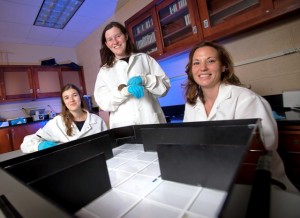By Sean Grim ’14
Imagine yourself lying in bed, hearing and feeling sensations, but unable to move a muscle beyond blinking.

Alex McCullough ’16, Sammy Chavin ’16, and Professor Lisa Gabel work in the mouse model lab.
This is a constant reality for those suffering from Locked-In Syndrome. Lisa Gabel and her research assistants are conducting research aimed at allowing them some movement—and a new lease on life.
Neuroscience major Alex McCullough ’16 (Westport, Connecticut) is using an electroencephalography (EEG) cap, which looks like a shower cap sprouting electrical cables. Electrodes measure the electrical activity of the brain, allowing researchers to map neurological function.
She will use the neural activity to interface with computer software by controlling cursor movements on a computer screen. This kind of device is referred to as brain-computer-interface (BCI)—a machine that translates neural impulses from the brain into actionable signals by a computer, or external device, such as a helicopter or motorized exoskeleton.
McCullough is a member of an interdisciplinary research program run by Gabel , associate professor of psychology and chair of neuroscience, and Yih-Choung Yu, associate professor of electrical and computer engineering, to improve existing and develop new BCI devices. Other students working on the project this summer were neuroscience major Alexandria Battison ’16 (La Canada Flintridge, California) and electrical and computer engineering majors Tom Fuller ’16 (Asbury, New Jersey) and Brandon Smith ’17 (Sandy Hook, Connecticut).
The potentially life-changing impact of this research inspires McCullough, who’s participating through Lafayette’s EXCEL Scholars undergraduate research program. Gabel’s other EXCEL Scholar, Sammy Chavin ’16 (Mt. Pleasant, South Carolina) is working with Gabel on a very different project: studying the genetic basis for developmental dyslexia.
Gabel and Chavin use a mouse model of the disorder, which has a genetic mutation commonly found in humans diagnosed with dyslexia. Students working in Gabel’s lab examine learning and memory abilities in these “dyslexic mice” and then examine humans diagnosed with the disorder on virtual versions of the same tasks. As a result, their research has direct applications for individuals with dyslexia.
One of Gabel’s honors thesis students, Genevieve Curtis ’14, worked to develop a new tool for examining working memory and auditory processing, two areas of impairment common in dyslexic individuals, in this animal model. To further expand on her findings, Chavin, a neuroscience and French double major, is working to validate Curtis’ procedures. Preliminary data are promising and Chavin will continue this area of research to determine if “dyslexic mice” show impaired performance on this task.
Applications of the research may allow for early detection and therefore early intervention for children at risk for reading impairment, note Gabel.
“Often children are not diagnosed with dyslexia until later in childhood, after their struggles with spelling have manifested themselves in school,” she says. “The virtual mazes, which look like basic video games, may offer a mechanism for practitioners to test preschool children for the disorder, and get a jump start on their treatment.”
